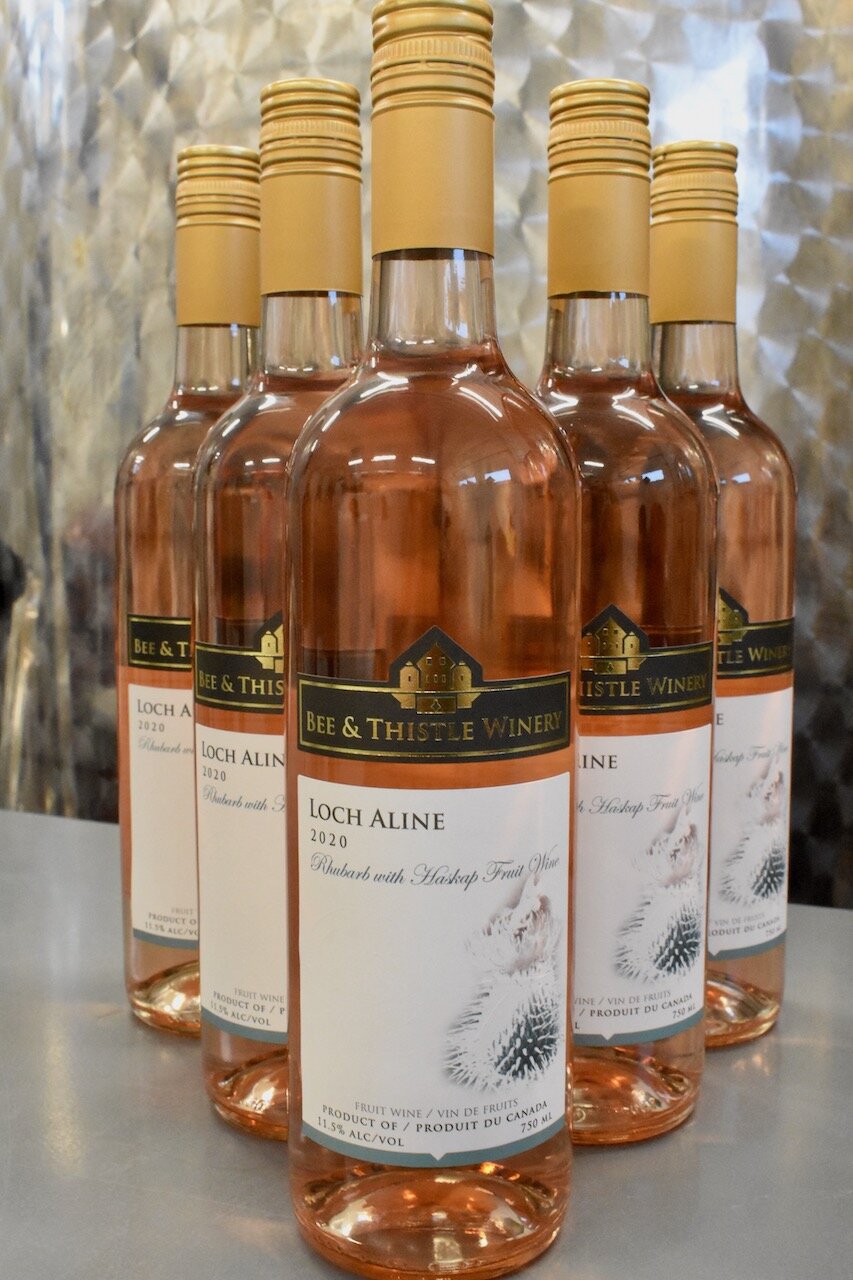Rhubarb Wine Vintages 2019 and 2020 and 2021
New York International Wine Competition
Awarded to Loch Aline Rhubarb with Haskap, 2020 Vintage
Rhubarb Wine General Notes
From a winemaking perspective, Rhubarb is a little difficult to work with. Firstly, there is a lot of pectin in Rhubarb, which will cloud the wine if allowed to persist untreated. Therefore, calculated generous quantities of an enzyme are added to break down the pectin and allow the wine to clear more readily upon completion of fermentation. We also add another specific enzyme which breaks down the sugar molecules attached to the aroma molecules, allowing for their expression and release of gentle aromatics specific to Rhubarb. The second issue with Rhubarb is high acidity. Portions of the Rhubarb fruit are deacidified to an alkaline level, and added back to the original mix, achieving an ultimate overall calculated specific end goal for my stylistic choices in acid balance/tanginess.
After the addition of calculated nutrients and yeast enhancers according to specific lab tests, the ferment is conducted on fruit in tubs for a few days, at which time we press out the juice and discard the pulp as compost for the orchards. We may also experiment with other products if the tests show increased complexity and enhanced fruit on the palate.
Rhubarb Wine Vintage 2019
From frozen German Wine Rhubarb, Rhubarb wine vintage 2019 was started in late May, 2020. We began with approximately 800 L.
Yeast Selection: Specific yeast to address the cool to cold fermentation we want to conduct. Specific yeasts are not mentioned due to proprietary reasons.
Starting Brix: with a goal of approximately 12% alc/vol. Rhubarb wine is softly citrus and aromatically tropical; we did not want the alcohol to overwhelm the unique expression of those notes. A small amount of adjustment with other constituents will be made.
Batch 2020 Haskap was used for blending in a small amount, with a beautiful peachy pink colour resulting (after a Bench Trial). The taste is unique, and accents the Rhubarb profile in a very pleasing way. This blend was allowed to meld. Heat stability, acidity check, fining and sweetening trials were performed in house. From the results of those trials, we fined with select products, settled and filtered through the stages, and backsweetened according to taste and desired profile.
Loch Aline 2019
Rhubarb with Haskap
12% alc/vol
Bottling: November 21, 2020 Release: Late January, 2021
750 mL Bordeaux Flint (1150 bottles; 96 cases)
Semi-sweet with crisp acidity; classic Rhubarb, notes of mango and grapefruit, long Rhubarb finish with a little Haskap mystique
The colour starts out Vivid but as Wine develops, it subdues.
Rhubarb Wine Vintage 2020
We harvested the German Wine Rhubarb in mid-June, 2020 and froze the fruit for two weeks. Frozen fruit is easier to macerate and it releases its juice more readily than fresh. We began with approximately 800 L of Rhubarb wine vintage 2020.
Yeast Selection: Select yeast (proprietary secret) at a generous 25 g/HL. This yeast was selected due to its ability to express aroma and citrus/tropical fruit by fermenting at a decidedly low temperature. The tanks were maintained at 15-17C with the use of glycol chiller plates.
Starting Brix: goal of approximately 11.5 - 12% alc/vol. We maintained the ferment at 15-17C throughout and quickly noted the grapefruit and citrus notes, even early on before fermentation was completed. This flavour profile is expected to develop through the tank aging in September and October. This batch also received a small amount of tweaking adjustments as suggested by the tests we did in May.
Specifically selected strain for the inoculation of cold ..must (even as low as 10°C/50°F) and for its aroma preserving capabilities.
Wines produced with select yeast are known to promote the following aromatics: citrus, grapefruit, apple and peach.
A fast fermenter with low nitrogen requirements, the recommended temperature range is between 13–17°C (55–62°F).
Select yeast is tolerant up to 15% (v/v).
The wine was allowed to settle and mature a bit before being blended with with a small quantity of Haskap, which was trialed in the lab and found to accent the attributes of the German Wine Rhubarb, as well as providing a bit of mystique to the final profile.
The resulting blend was melded and aged for a further time, during which time we also fined and filtered similarly to LA2019, and backsweetened to a slightly lesser degree. Since the profile was a bit more intriguing, we did not want to mask the astringency and development of the tannin, which had complexed nicely over the course of tank aging and will further develop in bottle. We also balanced the acidity profile. The colour is just a hint stronger than LA2019, which we expected. Very nicely balanced wine, a bit tart and a bit sweet (but not too much), with classic Rhubarb palate and nose, and tropical overtones.
Loch Aline 2020
Rhubarb with Haskap
11.5% alc/vol
Bottling: December 19, 2020 Release: End January, 2021
750 mL Bordeaux Flint (845 bottles) and Antique Green (300 bottles); 95 cases
Antique Green selected for bottles set for longer aging period.
Semi-sweet with balanced acidity; classic Rhubarb varietal with tropical fruit notes and a tease of Haskap mystique
Proud recipients of the 2021 New York International Wine Competition’s Canada Winery of the Year Award
Proud recipients of the 2021 New York International Wine Competition’s Bronze Award (90 points)











